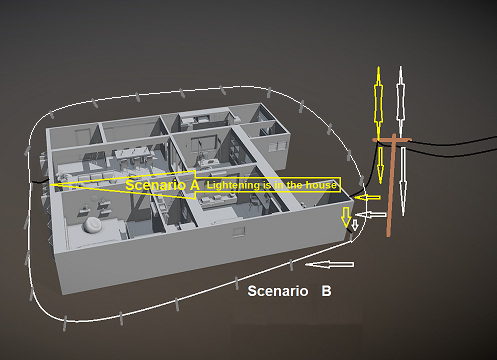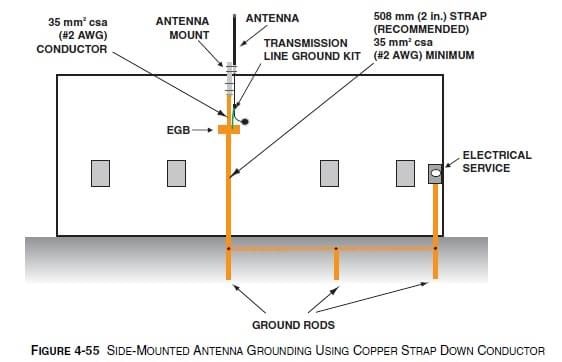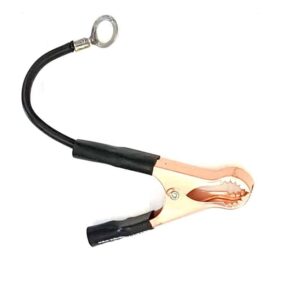RF grounding for lightning protection and lightning arrestors

RF grounding, Lightning arrestors, and Lightning protection with grounds. Let’s get into it!
Whether you are wanting to keep RF power from touching your lips on a hot mic or to protect your home and equipment from lightning, this information is for you.
What a RF ground is and what it isn’t?
The most common misconception is that a RF ground rod is a lightning ground, and a lighting arrestor protects equipment. A RF ground rod is actually a ‘static drain’. A RF ground serves to ‘bleed off’ or ‘drain away’ potentially problematic current, such as excess static build-up. This can lessen the chance of lightning striking a ‘communication system’. It is often very difficult, however, to protect a communications system from a direct, or even sometimes an indirect, lightning strike.
REMEMBER, there are no guarantees with Lightning!!!! All you can do is to give it probable or less likely paths to go, which is the function of a lighting arrestor.
Grounding mistakes & Corrective action
Common grounding mistakes are when you use multiple ground rods that do not have proper bonding and when wire is installed at a 90-degree angle and not curved. Corrective Action: Grounding for lightning protection places a heavy wire in a loop around the outside of a house, which are bonded to ground rods spaced at twice their depth. Only then should lighting arrestors and equipment grounds be connected.
What’s wrong with having a dedicated station RF ground?
Having two ground rods enables lightning to travel through your home’s electrical wiring and equipment to reach both ground rods. See Scenario A in the attached image.
This is possible when you have a RF ground rod for your station, which does not have correct bonding to your homes ground rod. Basically, lightning that strikes on the power pole side will see two ground potentials, and potentially a third if you have another ground rod at your lighting arrestor. First your home’s ground rod and then your stations ground rod. This path can cause a house fire or damage equipment.

How to properly ground your station for lightning protection?
Lightning protection is actually very simple to explain. A proper installation, on the other hand, can seem difficult.
Here are the things to look for when properly installing a ground, per Scenario B:
- A proper ground scenario for lightning protection would include an already installed a ground rod at your homes service entrance by a certified electrician. Again, this should already be in place, yet you should check to ensure your home includes one. (Hint: In newer homes the Service Entrance ground rods are typically directly below the meter on the house. In old homes, pre ~1950, they could run a ground wire [ ~ #6] possibly inside the foundation or in the basement to the water supply pipe for the house.)
- The second 8-foot or 10-foot ground rod would be close to your station. It would include a short heavy gauge solid wire that goes to the RF ground bolts on the back of your equipment.
- The short heavy gauge wire should be less than quarter wavelength of the highest frequency in use. If it is not, then the ground wire will begin to appear to your transmitted signal to be a random length antenna element.
- A #4 CU stranded wire would then be run around the perimeter of your house per Scenario B without 90-degree bends, but with curves. This perimeter wire would connect to your homes ground rod to your second ground rod, with 8-foot ground rods at 16-foot (or 10-foot ground rods at 20-foot) intervals. At each ground rod the wire would have a direct common bond. The perimeter wire would also have no sharp turns, meaning the radius of a turn should be no less than about 3 ft/1 m. Once installed, the wire and rods would need to be entirely covered with dirt.
- Although Lightning Grounds are OK with mechanical connections, it is better is to braze the bonded ground rods and wires together. This would include other conductive mechanical structures used for communications, including a tower. In commercial installations CAD-WELDING is used for bonding.
- Then it is now possible for a properly grounded inline lightning arrestor can be inserted between your antenna and equipment.
Alternative path to a ground
If the scenario shown above is not possible, then you might consider using the following Grounding Alternative in Figure 4-55 from the Bureau of Land Mangement (Lands_ROW_Motorola_R56_2005_manual.pdf (blm.gov)). As a last resort, you might consider using your home’s safety ground. This would entail trusting your home’s safety ground, which your equipment plugs into, to provide the protection you some level of protection.

RF Ground for your equipment
There are ground bolts on the back of your equipment, which should be used after a proper ground is installed. Otherwise, using your home’s safety ground is another popular means to enable the RF ground on your equipment to connect to your home’s ground rod. An inline lightning arrestor can also now be used.
What about lightning arrestors?
Protectors such as a Transi-Trap or a Poly-Phaser are only as good as the lightning ground they connect to. They shunt any surges coming down the center conductor of the coax to the ground. Please note that these only add protection to what they connect to.
Test if your ground rods are working
Ground rods are only as effective as the ground conditions. You can only determine a ground rods effectiveness by using a meter to find the lowest level of impedance.
Conclusion
To protect against lightning there are two paths to remember.
- First is the path you want a direct strike to take. That one should be as straight as possible.
- Second is the path you don’t want the strike to take. This is where you would put inductance between your equipment and where it comes into your house. For example, on the antenna side, put a lightning arrestor or single turn of coax on each coax before it enters the house. This way, lightning will see or look for a better path to ground.
Credits
Credit for review and updates of the original text from Alpha Antenna goes to:
Robin Cross
w0fen
RC Electronics LLC
ret CE KCUR, WNIU / WNIJ

